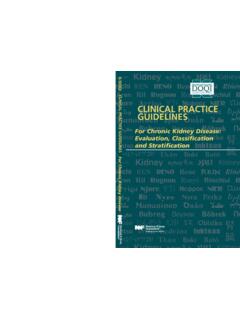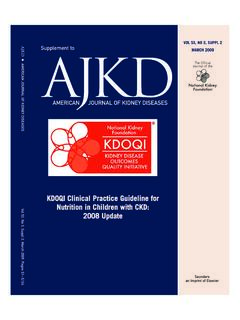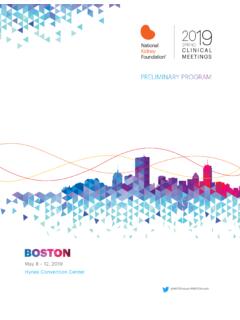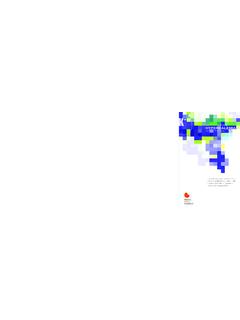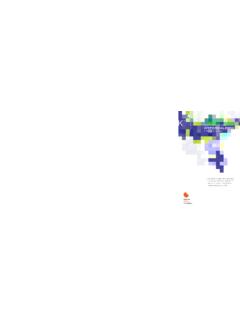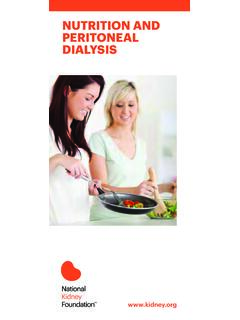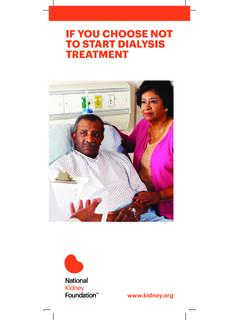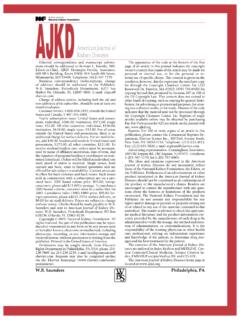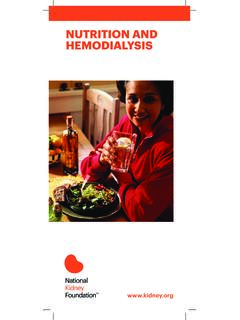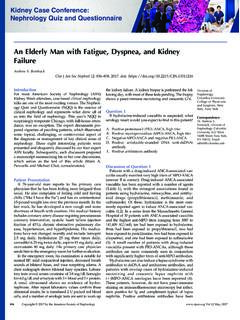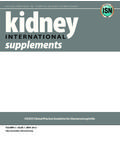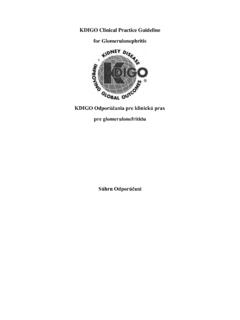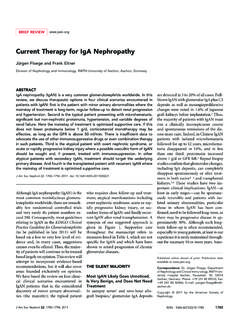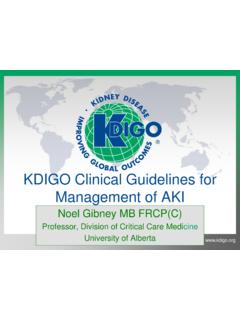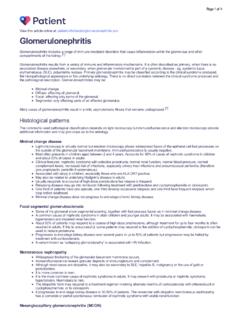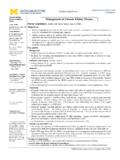Transcription of Managing KIDney transplant reCIpIents
1 Managing KIDney transplant RECIPIENTS1 Managing KIDney transplant reCIpIentsBased on select guidelines from KDOQI US Commentary on the 2009 kdigo clinical Practice Guideline for the Care of KIDney transplant reCIpIents . To view full publication, visit clinical GUIDE for Nephrology and transplant Professionals on: Induction Therapy Maintenance Immunosuppression Managing Adverse Effects Acute Rejection and Chronic Allograft Injury Screening and Graft Monitoring Cardiovascular Disease Cancer Infection Other Complications Other Complications2 NATIONAL KIDney FOUNDATIONInItIal ImmunosuppressIonRecommend starting combination immunosuppressive (IS) therapy before, or at the time of, transplant [R (1A*)] except perhaps for transplantation between identical THERAPY Recommend a biologic agent as part of initial IS medication.
2 [R (1A)] Intended to improve the efficacy of immunosuppression by: Reducing acute rejection, or Allowing a reduction of other components of the regimen, such as calcineurin inhibitors (CNIs) or induction therapy: recommend using an interleukin 2 receptor antagonist (IL2-RA). [R (1B)]Induction therapy for high immunologic risk: recommend using lymphocyte-depleting agent. [R (2B)]TOXICITY PROFILES OF IMMUNOSUPPRESSIVE MEDICATIONSA dverse EffectSteroidsCsATacmTORiMMFAZANew-onset diabetes mellitusFFFFFD yslipidemiasFFFFH ypertensionFFFFFO steopeniaFFF(F)Anemia and leucopeniaFFFD elayed wound healingFDiarrhea, nausea/vomitingFFFP roteinuriaFFDecreased GFRFFAZA, azathioprine; CsA, cyclosporine A; GFR, glomerular filtration rate; MMF, mycophenolate mofetil; mTORi, mammalian target of rapamycin inhibitor(s); Tac, indicates a mild-moderate adverse effect on the indicates a moderate-severe adverse effect on the complication.
3 (F) indicates a possible, but less certain adverse effect on the complication.*See table on page 11: Rating Guideline US transplant centers determine immunosuppression protocols based on their particular patient population, organ source, experience, ease of use, and cost of therapy. Ethnic diversity of the population and the number of high-risk patients vary in different regions of the US, which explains in part variations in protocols used in different Commentary: Managing KIDney transplant RECIPIENTS3maI ntenanCe ImmunosuppressIon Recommend using a combination of IS medications as maintenance therapy, including a CNI and an antiproliferative agent, with or without corticosteroids.
4 [R (1B)] Recommend measuring CNI blood levels [R (1B)]: Every other day during the immediate postoperative period until target levels are reached (2C) Whenever there is a change in medication or patient status that may affect blood levels (2C) Whenever there is a decline in KIDney function that may indicate nephrotoxicity or rejection (2C). Suggest using tacrolimus as the first-line CNI. [R (2A)] Suggest monitoring tacrolimus using 12-h trough (C0). [ (2C)] Suggest using mycophenolate as the first-line antiproliferative agent. [R (2B)] Suggest monitoring mycophenolate mofetil (MMF) levels. [ (2D)] Suggest that in patients who are at low immunological risk and who receive induction therapy, corticosteroids could be discon-tinued during the first week after transplantation.
5 [R (2B)] Suggest using the lowest planned doses of maintenance IS medications by 2 to 4 months after transplantation if there has been no acute rejection. [R (2C)] If using prednisone beyond 1 week after transplantation, continuation is suggested over withdrawal. [R 2C)] Nonadherence is associated with a high risk of acute rejection and allograft loss. Consider providing all KIDney transplant reCIpIents (KTRs) and family members with education, prevention, and treatment measures to minimize nonadherence to IS medications. [R (not graded)]INITIAL MAINTENANCELONG-TERM MAINTENANCEI nduction Immunosuppression 78% used induction therapy, composed of: Thymoglobulin in 39% Interleukin 2 receptor antagonist in 28% Alemtuzumab in 9% Other in 2% 22% did not receive induction therapyInitial Immunosuppression (at discharge) 94% on CNI, composed of: 15% CsA 79% Tac 87% on MPA 9% on mTOR inhibitor 26% steroid freeMaintenance Immunosuppression (1 year and beyond) 99% on CNI 87% on MPA 18% on mTOR inhibitor 20% steroid freeKDoQI Commentary.
6 In the US, decisions on immunosuppression are made by the transplant center and any alterations should always be made in concert with them. Dosing of immunosuppression should at all times take into account the individual patient s risk profile, balancing rejection with the adverse effects of medications. Community nephrologists need to coordinate any alterations in IS medications with the transplant center and be vigilant for potential drug interactions with the addition of any new general, the transplant community (patients, healthcare providers, and policy makers) needs to embrace the concept of cost containment and the risk(s) to the patient and graft from these measures.
7 However, this needs to be balanced between who benefits and how much risk is at stake. Although data about the efficacy and safety of steroid-free regimens are still evolving, it is clear that if steroids are to be eliminated, this should be done in the early transplant period and not later (after 1 year).2006 OPTN/SRTR ANNUAL REPORTCNI, calcineurin inhibitors; CsA, cyclosporine; MPA, mycophenolic acid compounds; mTOR, mammalian target of rapamycin; OPTN/SRTR, Organ Procurement and Transplantation Network/Scientific Registry of transplant reCIpIents ; Tac, KIDney FOUNDATIONaCute rejeCtI on and ChronIC allograft InjuryPOSSIBLE RISK FACTORS FOR ACUTE REJECTION The number of human leukocyte antigen (HLA) mismatches Younger recipient age Older donor age African-American ethnicity (in the United States) Panel-reactive antibody (PRA) >30% Presence of a donor-specific antibody Blood group incompatibility Delayed onset of graft function Cold ischemia time >24 hoursTREATMENT OF ACUTE REJECTION Recommend biopsy before treating acute rejection, unless the biopsy will substantially delay treatment.
8 [R (1C)] Treat subclinical and borderline acute rejection. [R (2D)] Suggest adding MMF, if appropriate. [R (2D)]Acute Cellular Rejection Recommend using corticosteroids for the initial treatment. [R (1D)] Suggest adding or restoring prednisone in patients not on steroids who have a rejection episode. [R (2D)] Suggest using lymphocyte-depleting antibodies or OKT3 if [R (2C)]: Nonresponsive to corticosteroids Acute cellular rejection is Acute Rejection Suggest treating with one or more of the following alternatives, with or without corticosteroids [R (2C)]: Plasma exchange Intravenous immunoglobulin Anti-CD20 antibody Lymphocyte-depleting OF CHRONIC ALLOGRAFT INJURY (CAI) Recommend a KIDney allograft biopsy for all patients with declining KIDney function of unclear cause to detect potentially reversible causes.
9 [R (1C)] For patients with CAI and histological evidence of CNI toxicity, suggest reducing, withdrawing, or replacing the CNI. [R (2C)] Withdrawing the CNI should occur only after attempts at decreasing the dosage have failed. One also must ensure that all other causes of CAI are excluded to avoid inappropriate drug adjustments or missed treatment optionsKDoQI Commentary:Decision making regarding appropriate initial treatment for acute rejection should be based on clinical and pathologic information. Regular surveillance of the patient s KIDney function, at the transplant center or in the nephrologist s office, offers an opportunity to enhance patient adherence to medication, diet, and healthy KIDney transplant RECIPIENTS5sCreenIng and graft monI tor Ing Detecting KIDney allograft dysfunction as soon as possible will allow timely diagnosis and treatment that may improve outcomes.
10 Suggest including a KIDney allograft ultrasound examination as part of the assessment of KIDney allograft dysfunction. [R (2C)]ROUTINE SCREENING AFTER KIDney TRANSPLANTATIONS creening TestScreening Intervals by Time After Transplantation1 week1 month2-3 months 4-6 months 7-12 months>12 monthsCreatinineaDaily2-3 per weekWeeklyEvery 2 weeksMonthlyEvery 2-3 monthsUrine proteinbOnceEvery 3 monthsAnnuallyComplete blood countcDaily2-3 per weekWeeklyMonthlyAnnuallyDiabetesdWeekly Every 3 monthsAnnuallyLipid profilee Once AnnuallyTobacco usefPrior to discharge AnnuallyBKV NATgMonthlyEvery 3 months EBV NAT (seronegative)hOnceMonthly Every 3 months Blood pressure, pulse, height, body weightEach clinical visitBKV, BK polyoma virus; EBV, Epstein-Barr virus.
